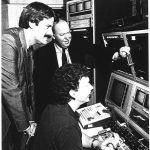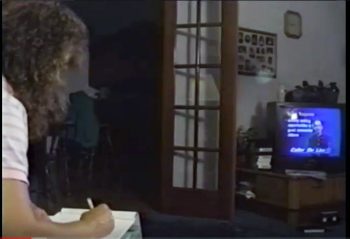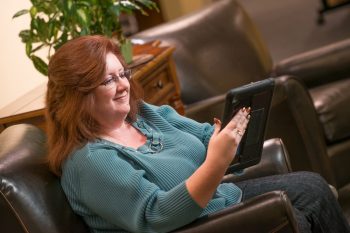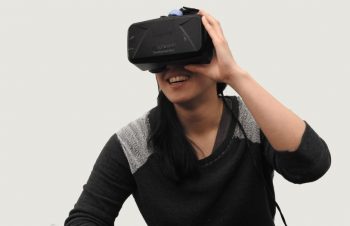Journey from the first ITV proposal in 1985 to the delivery of over 47,000 distance credit hours in Academic Year 2018-19.
A Pioneer in Distance Education
UMA has been a pioneer in providing higher education to students at a distance, from the very first courses broadcast via ITV to today’s highly interactive online courses.
For many, it is hard to remember a time when information could not be accessed, literally, in the palm of your hand. A time before smartphones and PCs, when Facebook and Instagram were not part of a world wide web connected citizenry. Thirty years ago, UMA, with University of Maine System support, was on the cusp of this technological movement with a goal of reshaping access to higher education across the state of Maine and beyond.

The University of Maine System has gone high-tech to bring college to every corner of the 33,000-square-mile state…There are similar programs in other parts of the country, but none is as extensive or covers a state as thoroughly as Maine’s.
— Bangor Daily News Archive, 1991

In the early years of ITV, students were able to tune in to their courses at their local center or receive site at the scheduled time. Staff at each location were responsible for recording a copy of the class on a VHS tape. This required vigilance to know when to take out a full tape, replace it with a fresh one, and hit “record” once more.
In special cases, students could reserve a time to come in and watch a recorded class if they were unable to attend the live session. Students could not borrow a tape to bring home and watch, because there were often multiple students who needed to access this single VHS tape. Attendance records were kept meticulously by staff members, who would write down the student’s name, date, and exactly how long they spent watching the recorded video.
Academic Logistics was a hub of materials going back and forth. Each off-campus center and site appointed an individual to be responsible for distributing, proctoring, and collecting exams and returning them to the appropriate faculty member. When students would submit assignments, a staff member at each location would collect the assignments, stamp them with the time and date of submission, and place them into pre-paid USPS distribution envelopes. Faculty members would grade the assignments and mail them back to the students’ locations in the same manner. Over all, this process could take at least a week.

What was created in 1989 was the first statewide comprehensive distance-learning network in the United States. Educators came from all over the country to learn first-hand what we were doing.
— George Connick

Students enrolled in online courses at UMA today can expect various methods of engaging with their instructors and fellow students through the use of technology. Whether tuning in from the state of Maine, elsewhere in the United States, or internationally, the various technology UMA utilizes allows all distance students to interact, engage, learn and apply their learning in unique ways.
From pre-recorded lectures which allow students to work on their time, to live interactive video lectures and synchronous chat and video sessions, students can tailor their learning experience and engage at various levels with their instructors, classmates, and content. Our online classes work to meet the needs of our students and their varied approaches to learning.
Some classes meet weekly at a local UMA Center or site, while others hold class completely online through videoconferencing software. Many faculty members allow students who are not be able to attend at the scheduled time to participate by watching the lectures automatically recorded from class, and collaborate with classmates in BlackBoard to complete and share work. Faculty can provide feedback directly on submitted papers without ever having to print them. Audio feedback can even be attached for students to download and listen to, and quizzes and some tests may be graded instantly!
Academic Logistics still supports and coordinates proctored exams for students around Maine and the US, and submits work instantaneously to faculty for evaluation. Students have easy access to their academic advisors and can book calendar appointments online. Overall, UMA optimizes the use of various technology to meet students where they are.

UMA allows you to obtain quality degrees, in a flexible format regardless of location. Distance education allows the students to find balance with competing demands on time, while being able to achieve their educational goals. It was true in 1989 and it is still true today, we bring our classrooms to the students where they are.
— UMA Provost Joe Szakas
 The past 30 years have demonstrated the vital role that technology can play in delivering education outside a traditional classroom. As technology improves, so does the level of engagement between professors and students, as well as the ease of access. The potential of new technologies, such as a makerspace and a collaboratory, as well as virtual reality have yet to be examined fully and may have the promise to transform, again, the distance education experience.
The past 30 years have demonstrated the vital role that technology can play in delivering education outside a traditional classroom. As technology improves, so does the level of engagement between professors and students, as well as the ease of access. The potential of new technologies, such as a makerspace and a collaboratory, as well as virtual reality have yet to be examined fully and may have the promise to transform, again, the distance education experience.
What the future of distance education holds remains to be seen. However, UMA will continue to pursue cutting-edge technologies and seek opportunities to provide high quality education and student support in fulfilling its mission of making higher education accessible to those in Maine and beyond.

UMA continues to be an institution transforming the lives of students of every age and background across the State of Maine. As the technology evolves, UMA will also evolve to provide the highest quality distance education possible.
— UMA President Rebecca Wyke

